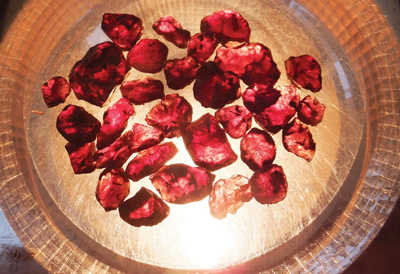April 2025 Issue Available At All Leading Newsagents!
Read the featured article from this month’s issue below
Garnets & Flies At Fullarton River
In January 1861, the ill-fated Burke and Wills expedition through central Australia reached a creek that Burke named Cloncurry, after his aunt, Lady Elizabeth Cloncurry of County Galway. I very much doubt the good lady even knew where it was let alone visited the place but if she was alive today she might have wished Burke had pegged a mineral claim for her instead of just naming it after her.
Cattle and mining have contributed to the economy of Cloncurry for more than a hundred years but it has been mineral exploration that has brought to light the numerous gemstone localities we enjoy visiting today The Cloncurry area covers all of my favourite gemstones, as I mainly like hard crystals, and my favourite colours, in order, are purple, red, black and yellow. I had already been down to Kuridala and got a little purple amethyst (although a little was disappointing), so red coming next meant garnet and there was no better place to hunt them than at Fullarton River.
Cloncurry in October has always guaranteed us hot weather somewhere around the 40-degree mark, and this trip was no exception. As we travel north each year we acclimatise as we go and 40-degrees in Cloncurry is far better than 10 degrees, windy and raining, in Melbourne.
The garnet site is on Maronan Station and one of the main things the station owners insist on is no travelling on the station roads in wet weather.
We don’t bother with TV while we’re travelling, so we don’t get any weather reports and while I was filling up with fuel the day before our planned trip, I asked the garage attendant whether there was any chance of rain the next day. He gave me a look that said ‘You must be an idiot’, before answering me with, “If you run into some bring it back with you."
My First Gold Ring
Finally a ring of some worth but I must admit I did cheat. A guy I know asked me if I could look for his wedding band that he’d lost approximately 14 years ago while out fishing in waist-deep water. He showed me the spot and even though I figured my chances were none and Buckley’s, the following morning, armed with my trusty Sovereign GT and a very low tide, I gave it a go. Tuning the detector on the beach I got a signal and out popped an 1881 English threepence. Ok, so that was cool and a good way to start the hunt.
The target area was on a low, craggy reef that ran for a 100 metres or more out to sea so I detected my way towards it and a couple of pieces of junk and three sinkers later I was in the target zone. I quickly got a signal down near a sizeable crack in the reef and after a bit of digging and shifting of rocks, lo and behold there it was! Absolutely amazing. I really hadn’t held out much promise of finding it after such a long time, particularly with all the rough seas that you can get along this stretch of coast, but gold is heavy and it just stayed put pretty much where he’d lost it.
It was a happy ending all round because I got to find my first gold ring and he got his gold wedding band back after 14 years in the sea.
The Prospectors Who Missed
Since way back in 1864, when explorer Charles Cooke Hunt, threading his way from rock hole to rock hole across parched country, passed within the proverbial hair’s breadth of the spot where Bayley and Ford 28 years later made their discoveries which were to set the mining world agog, there have been many instances in Western Australian mining history of bonanzas that have been passed over by explorers and unlucky prospectors and of fortunes that have been narrowly missed through a variety of circumstances.
Fate has played some strange tricks in the gold-searching game. It is the glorious uncertainty, the fortune that is always thought to be awaiting the next stroke of the pick that has fascinated men throughout the ages, enticing them to brave hardship and death in a search for the elusive metal. What to one man has looked merely a worthless quartz outcrop has to another been a storehouse of wealth, and thousands of boots have trodden ground which later yielded wonderful slugs.
Early in 1894 a party passed within a stone’s throw of the spot, 12 miles south of Coolgardie, which all the world was to know a little later as the Londonderry, without seeing a sign of gold.
It was left to John Mills, Huxley, and their four mates to knock the precious metal from the reef, more than £30,000 being dollied by them within a few weeks. The story is told that Mills, a native of Londonderry, not long over from New South Wales, lay down to have a smoke one evening, a bold outcrop at his feet. Imagine his feelings when he found the outcrop contained gold in abundance. But Mills was not excited. After supper he told his mates he had something to show them, and leaving the camp he returned with his hands full of specimens. They worked day and night getting out the gold by the lost primitive methods, and had about 8,000oz before Coolgardie knew of their discovery.






